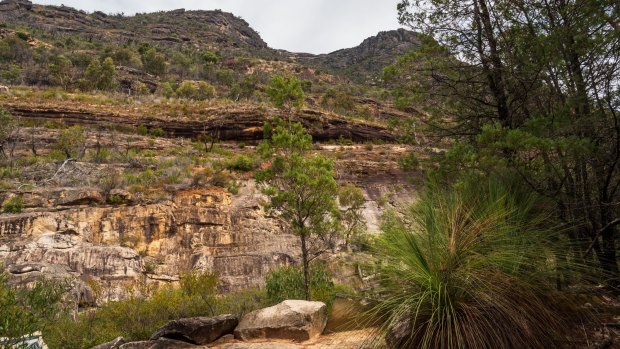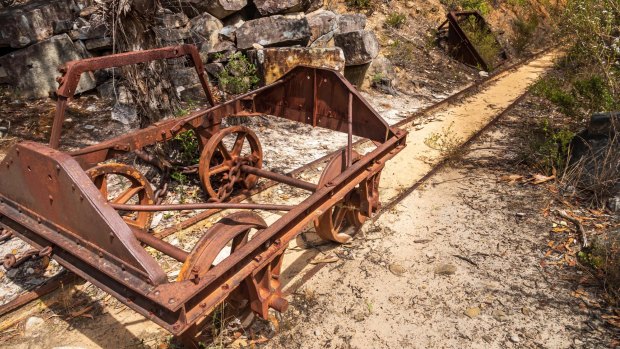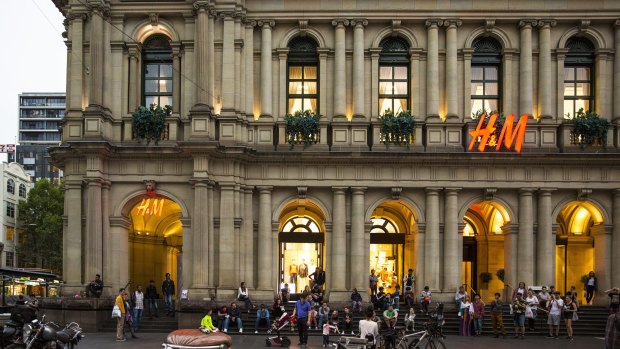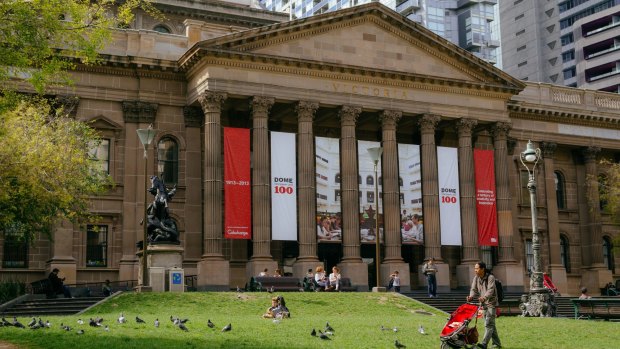This was published 3 years ago
Heatherlie Quarry: The ugly, abandoned hole that created Melbourne

Heatherlie Quarry near the Grampians was the source of stone for many of Melbourne's most important buildings.Credit: Chris O'Connell
Melbourne's grandest buildings were shovelled out of a hole in the ground. Obviously, of course, if you've ever thought about it. But who thinks much about where building material comes from? Not travellers. Travellers admire buildings already constructed, or attractively ruined. We care much less about how they were born.
You can visit the womb of Melbourne, though. You can see the spot where all those gracious turrets, pompous pillars and civic curlicues of the town hall and state library came from. Their raw materials. The dusty and violent process by which they came into being, and the humble origins of the city's boastful architecture.
That place is Heatherlie Quarry, deep in rural Victoria on the northeast edge of the Grampians National Park. If you ever visit this region – and with the Grampians' dramatic peaks, waterfalls and wildflowers why wouldn't you – then you should certainly drop by this overlooked remnant of industrial heritage. This hole in the ground might not be worth a journey in itself, but is certainly worth a detour.

Abandoned mining equipment can still be seen at the quarry. Credit: Chris O'Connell
From the carpark on Mt Zero Road a flat, easy track leads through bushland for just over a kilometre to the historic site. Soon you'll come across a gigantic old boiler that lies amid crackle-dry grasses and brittle drifts of gum leaves like the body of a wounded brontosaurus.
Nearby is the skeleton of an old crane, as well as winches that resemble the claws of a velociraptor, rusting cogwheels and the rails of a tramway line.
The dinosaur comparisons come easy thanks to the giant size of the abandoned machines and the way they point to a lumbering, less refined past. Industrial sites are rarely preserved, but here quarrying methods are showcased, along with the sweaty efforts that European settlers faced in sourcing natural resources from remote areas.

The GPO in Bourke Street Mall is now a shopping arcade.Credit: Josie Withers
Early Victoria had to import its sandstone. Then in the mid-1860s a stone mason called Francis Watkins was hunting at Mt Difficult when he spotted the region's high-quality, durable rock.
He took out a lease on the land and by the 1870s was supplying gold-rush town Stawell with stone for its courthouse, Anglican and Catholic churches, town hall and tombstones. By 1882 a tramway connected Stawell with the quarry.
A visiting parliamentary party was so taken with Stawell's courthouse that it decided Parliament House should be built of the same material. Heatherlie's sandstone had excellent grain, texture and colour. It was weather resistant but easy to work. By 1880, its blocks were being hoisted onto Parliament House.

The State Library of Victoria. Credit: Roberto Seba
The quarry would go on to supply stone for Melbourne's town hall, state library, GPO, Regent Theatre and Port Authority Building, among others. And so stone from the ugly-duckling site of this little bush quarry was transformed into some elegant architectural swans.
Much of what you see at Heatherlie Quarry dates from its 1890s heyday, when it employed a hundred workers. After the Second World War the quarry began to peter out, and its stone was used mainly for the repair of existing buildings.
You can rummage around the entrails of machines, tanks for storing compressed air and rust-red tramway trolleys. Orchids and wildflowers create a dainty contrast to the steampunk leftovers.
Several partially renovated cottages were once home to Italian immigrant workers though most quarrymen camped or commuted from Stawell or Fyans Creek.
All this is explained by useful signage, which also displays photographs of the quarry in action.
One picture shows workers in waistcoats and jackets standing in front of a locomotive that belches steam like a dragon. Another captures quarrymen stripped down to shirts and braces as they swing hammers and load railway trolleys.
In the early days, explosives were used to blast the stone out of the hillside; you can see the pits in the earth were the explosives were stored. This rambunctious approach to quarrying was soon abandoned, as it wasted too much stone.
The stone would later be separated along fracture lines by use of wedges and plugs, an ancient technique used since the time the Egyptians were building their pyramids.
You can still see the drill lines on the rock face, and the blocks of stone tumbled at its foot like a set of dice shaken by a giant. A glimpse of Melbourne's messy birth, you might say, frozen in time, but not quite entirely forgotten.
DETAILS
STAY
The basic Plantation Campground near Heatherlie Quarry is run by Parks Victoria and has spaces for caravans, trailers and tents. Halls Gap, 15 kilometres south, has abundant accommodation options. See visithallsgap.com.au
VISIT
Heatherlie Quarry Heritage Site is in Grampians National Park, a three-hour drive northwest of Melbourne. See parks.vic.gov.au
Sign up for the Traveller Deals newsletter
Get exclusive travel deals delivered straight to your inbox. Sign up now.